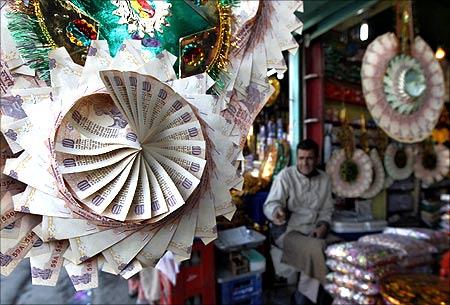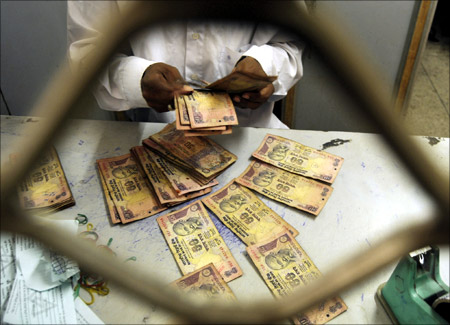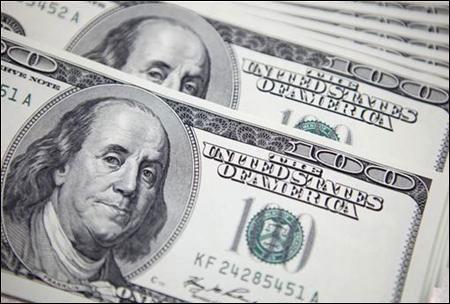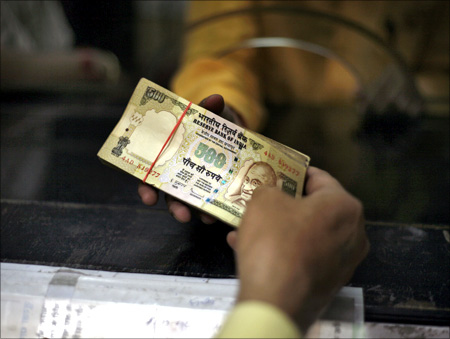
All the indicators point to a further steady weakening of the Rupee, says Kunal Kumar Kundu.
Having touched the 57 to a dollar mark, the rupee is now trading close to its yearly low - recording a depreciation of nearly 5.5 per cent in one month.
What is even more worrying is that it is falling even when the dollar is weakening, as indicated by the falling dollar index.
Had the rupee been mimicking only the dollar movement - leaving the trade-weighted index relatively unaffected - it would have been less of a headache.
But, given the rupee is also weakening against the euro, it indicates a broader malaise afflicting the economy.
...

After the Government of India announced a broader set of policy measures in early September (including FDI in multi-brand retail and a gradual increase in diesel and kerosene prices), which coincided with the announcement of QE3 in the US, the rupee appreciated nearly 7.8 per cent in a month.
Since then, it has been on a slide, save for some news and event-driven uptick in between. However, the general trend is one of depreciation.
Neither direct intervention (through dollar sales) nor policy intervention (such as increasing import duty on gold to curb gold imports, lowering withholding tax on interest incomes earned by foreign institutionl investors, or FIIs and qualified foreign investors on government and corporate bonds or raising the cap of foreign investment in government bonds) helped.
...

On the other hand, there will be occasional pressure on the rupee, as has happened of late owing to lumpiness of the foreign debt repayment schedule, or increasing demand for dollars by the importers (and holding onto foreign currency by the exporters in anticipation of further weakening of rupee).
The rupee will face additional headwind since sustained improvement in the US economy will lead to the Fed unfolding its QE exit strategy in the near future, instigating another bout of risk-off mode for foreign investors.
The basic problem, however, is more fundamental. Essentially, India has been unable to attract huge volumes of non-volatile non-debt creating flows.
...

While during the last quarter, India rejoiced its ability to finance its humungous current account deficit (CAD) through huge FII inflows, the volatile nature of such flows has come back to haunt us what with FIIs exiting en masse, as economic growth weakens and corporate performance falters.
According to a Business Standard report, an analysis of results of over 1,400 non-oil and non-financial companies for quarter-ended March 2013 shows that they are still struggling.
Their profitability reached the lowest level in six quarters, while sales grew by less than five per cent (essentially negative volume growth if one factors in inflation).
On the other hand, the deteriorating political climate and continued policy instability has taken the sheen off India's growth prospects, resulting in a slowdown in FDI inflows.
...

As domestic demand falters and private domestic investment suffers from inertia (the government's inability to clear hurdles facing such investments being a major cause), the fiscally challenged government is in no position to restart the investment cycle.
In fact, the recent clarification by the government that any new foreign entrant to the multi-brand retail space in India has to necessarily invest millions of dollars in back-end infrastructure (even disqualifying its existing investment in such infrastructure) shows that the government is in no mood to invest.
It wants to preserve as much resource as it can for its social-sector initiatives, including populist and poorly targeted spending, as they enter the home stretch of the forthcoming Assembly election. Sadly, foreign investors would be much less enthusiastic.
...

Moreover, the recent purchasing managers' index data indicate that the worse may not yet be behind us, despite India's gross domestic product for the fourth quarter of the previous financial year recording the lowest growth in the decade.
The rupee is under additional pressure as the spectre of twin deficit continues to haunt India.
While steps have been taken to contain fiscal deficit, the lower than anticipated fiscal deficit figure for the previous financial year is more of an accounting reality than an economic one. While CAD may still be lower this year, it will remain at worrying levels.
The recent easing of wholesale inflation may yet be a statistical fallacy, as I have explained earlier.
...

On the contrary, inflationary expectations remain high, as is indicated by growing divergence between the wholesale price index and the consumer price index. As a result, the real rate of interest in India is extremely low.
This will eventually manifest itself in the form of a rising CAD, thereby weakening the rupee and leading to further inflationary pressure.
Quite clearly, therefore, the rupee does not seem to have bottomed out, despite the recent bout of sharp depreciation. In fact, one may not rule out the possibility of even the 60 to a dollar mark being breached.
The author is a Delhi-based independent economist.